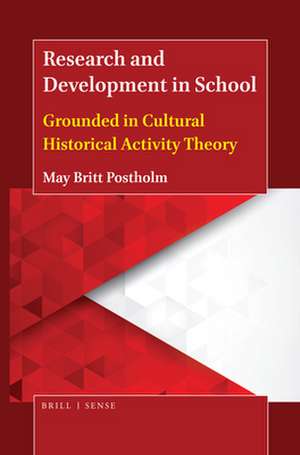Research and Development in School: Grounded in Cultural Historical Activity Theory
Autor May Britt Postholmen Limba Engleză Paperback – 17 iul 2019
Preț: 306.37 lei
Nou
Puncte Express: 460
Preț estimativ în valută:
58.62€ • 63.88$ • 49.40£
58.62€ • 63.88$ • 49.40£
Carte indisponibilă temporar
Doresc să fiu notificat când acest titlu va fi disponibil:
Se trimite...
Preluare comenzi: 021 569.72.76
Specificații
ISBN-13: 9789004410190
ISBN-10: 9004410198
Pagini: 154
Dimensiuni: 155 x 235 mm
Greutate: 0.27 kg
Editura: Brill
Colecția Brill
ISBN-10: 9004410198
Pagini: 154
Dimensiuni: 155 x 235 mm
Greutate: 0.27 kg
Editura: Brill
Colecția Brill
Cuprins
Preface
List of Figures
1 Introduction
1 Development Work Research and Research in School
2 DWR and Research at Valen School
3 The Aim of the Book
4 The Structure of the Book
2 Theoretical Perspectives and Cultural Historical Activity Theory
1 Different Theoretical Perspectives
2 Cultural Historical Activity Theory
3 The Activity System: Its Origin and Development
4 Researching Development Processes
3 The Qualitative Method: Its Historical and Theoretical Roots and Characteristics
1 Historical Roots
2 Theoretical Roots
3 Characteristics of the Qualitative Method
4 Researcher Roles and Access to the Research Field
1 Researcher Roles and the Aim of the Research
2 Access to the Research Field
5 Qualitative Research Approaches and Analysis
1 Case Studies
2 Ethnographic Studies
3 Phenomenological Studies
4 Narrative Studies
5 Text Analysis
6 Conversation Analysis
/
6 Data Collection
1 Observation as a Data Collection Strategy
2 Different Observer Roles
3 Interviews as a Data Collection Strategy
4 Types of Interviews
5 Questions That Help the Researcher Achieve Understanding
6 Connection between Interview and Observation
7 Practical Advice
7 Analysing the Data Material Using the Constant Comparative Analysis Method and D-Analysis
1 Introduction
2 The Point of Departure and Purpose of the Constant Comparative Analysis Method
3 The Importance of Theory When Using the Constant Comparative Analysis Method
4 Analytical Procedures in the Constant Comparative Analysis Method
5 Analysis of an On-Going Process
6 Contextual Circumstances in the Analysis
7 Asking Questions and Making Comparisons
8 Strategies in the Analytical Work
9 Categories and Structure in a Written Presentation
10 Background for the Project Used as an Example for the Constant Comparative Analysis Method and D-Analysis
11 Concluding Reflection
8 Quality and Ethics
1 Introduction
2 Knowledge – Constructed and Intersubjective
3 Concepts Representing Quality
4 Ethical Principles in Research
5 Quality and Ethics – A Summary
9 Writing up the Research Project
1 Introduction
2 The Thesis and the Researcher’s Position
3 The Recipients of the Thesis
4 The Introduction in the Thesis
5 Thick and Thin Descriptions
6 How to Structure the Text
7 Descriptions as the Starting Point for Further Analysis
8 Quotations Embedded in the Text
9 The Connecting Theme in the Master’s Thesis
References
Appendices
Appendix 1
Appendix 2
Appendix 3
Index
List of Figures
1 Introduction
1 Development Work Research and Research in School
2 DWR and Research at Valen School
3 The Aim of the Book
4 The Structure of the Book
2 Theoretical Perspectives and Cultural Historical Activity Theory
1 Different Theoretical Perspectives
2 Cultural Historical Activity Theory
3 The Activity System: Its Origin and Development
4 Researching Development Processes
3 The Qualitative Method: Its Historical and Theoretical Roots and Characteristics
1 Historical Roots
2 Theoretical Roots
3 Characteristics of the Qualitative Method
4 Researcher Roles and Access to the Research Field
1 Researcher Roles and the Aim of the Research
2 Access to the Research Field
5 Qualitative Research Approaches and Analysis
1 Case Studies
2 Ethnographic Studies
3 Phenomenological Studies
4 Narrative Studies
5 Text Analysis
6 Conversation Analysis
/
6 Data Collection
1 Observation as a Data Collection Strategy
2 Different Observer Roles
3 Interviews as a Data Collection Strategy
4 Types of Interviews
5 Questions That Help the Researcher Achieve Understanding
6 Connection between Interview and Observation
7 Practical Advice
7 Analysing the Data Material Using the Constant Comparative Analysis Method and D-Analysis
1 Introduction
2 The Point of Departure and Purpose of the Constant Comparative Analysis Method
3 The Importance of Theory When Using the Constant Comparative Analysis Method
4 Analytical Procedures in the Constant Comparative Analysis Method
5 Analysis of an On-Going Process
6 Contextual Circumstances in the Analysis
7 Asking Questions and Making Comparisons
8 Strategies in the Analytical Work
9 Categories and Structure in a Written Presentation
10 Background for the Project Used as an Example for the Constant Comparative Analysis Method and D-Analysis
11 Concluding Reflection
8 Quality and Ethics
1 Introduction
2 Knowledge – Constructed and Intersubjective
3 Concepts Representing Quality
4 Ethical Principles in Research
5 Quality and Ethics – A Summary
9 Writing up the Research Project
1 Introduction
2 The Thesis and the Researcher’s Position
3 The Recipients of the Thesis
4 The Introduction in the Thesis
5 Thick and Thin Descriptions
6 How to Structure the Text
7 Descriptions as the Starting Point for Further Analysis
8 Quotations Embedded in the Text
9 The Connecting Theme in the Master’s Thesis
References
Appendices
Appendix 1
Appendix 2
Appendix 3
Index
Notă biografică
May Britt Postholm, Ph.D., is professor in pedagogy and qualitative methodology at the Norwegian University of Science and Technology, Department of Teacher Education. She has published articles on teaching and learning and qualitative methodology in both national and international journals.
